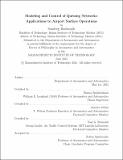| dc.contributor.advisor | Balakrishnan, Hamsa | |
| dc.contributor.author | Badrinath, Sandeep | |
| dc.date.accessioned | 2022-01-14T14:40:04Z | |
| dc.date.available | 2022-01-14T14:40:04Z | |
| dc.date.issued | 2021-06 | |
| dc.date.submitted | 2021-06-16T13:25:58.262Z | |
| dc.identifier.uri | https://hdl.handle.net/1721.1/138946 | |
| dc.description.abstract | The significant growth in air traffic over the past few decades has led to increased congestion at major airports worldwide. Airport congestion results in increased flight delays, fuel burn and emissions. There is consequently a need to accurately model airport traffic operations and to design control algorithms that mitigate airport congestion.
In this thesis, we propose a new class of queuing network models of airport surface operations that are capable of capturing congestion at multiple locations, and that can account for the time-varying nature of demand and capacity. The proposed queuing models are based on point-wise steady state approximation that result in a simple ordinary differential equation representation for the dynamics of the ensemble queue length. Further, the models can account for propagation delays between servers in the network, and handle general service time distributions, overcoming some of the limitations of the traditional probabilistic queuing models. The queuing models are developed, adapted, and validated using actual operational data from several major airports. These models also allow us to apply techniques from reachability analysis to better understand the performance of queuing networks.
The second part of this thesis focuses on the development of airport congestion control algorithms using the proposed queuing network models. The dynamical systems representation of the queuing process allows us to use optimal and robust control techniques to regulate the queue length, and to obtain theoretical guarantees for certain special cases. We compare our algorithms with NASA's logic that was recently field-tested, using stochastic simulations. We also investigate the impact of uncertainty in airline-supplied estimates of traffic demand on the efficacy of congestion control algorithms, and quantify the benefits of reducing this uncertainty. Finally, we note that the modeling and control techniques for queuing networks developed in this thesis have broad applicability in other contexts beyond airport surface operations. | |
| dc.publisher | Massachusetts Institute of Technology | |
| dc.rights | In Copyright - Educational Use Permitted | |
| dc.rights | Copyright MIT | |
| dc.rights.uri | http://rightsstatements.org/page/InC-EDU/1.0/ | |
| dc.title | Modeling and Control of Queuing Networks: Applications to Airport Surface Operations | |
| dc.type | Thesis | |
| dc.description.degree | Ph.D. | |
| dc.contributor.department | Massachusetts Institute of Technology. Department of Aeronautics and Astronautics | |
| dc.identifier.orcid | 0000-0002-9094-1079 | |
| mit.thesis.degree | Doctoral | |
| thesis.degree.name | Doctor of Philosophy | |
